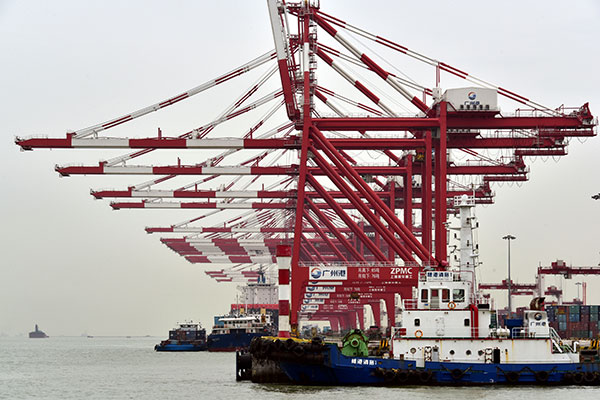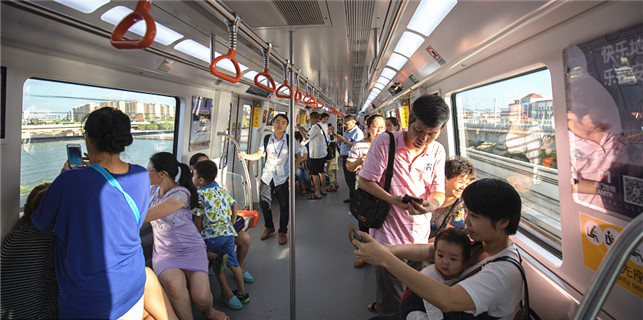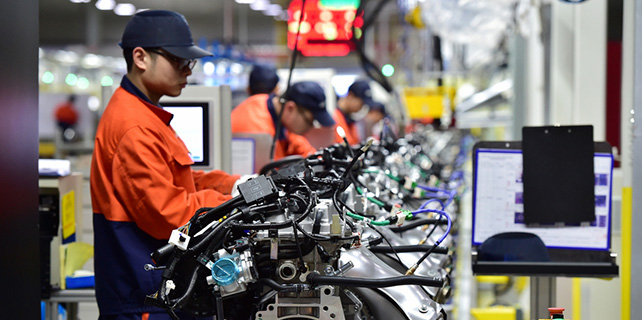Port's improvements expand commerce
 |
|
A tugboat is seen alongside cranes at Guangzhou's fast-growing Nansha Port in Guangdong province in June. [Reuters] |
Wu Jia'en used his cellphone to log into the Nansha Port's online registration system, finishing almost all the procedures for shipping goods in just half an hour.
"In the past, I had to wait about two hours to finish my business at the registration hall because of the large amount of cargo at the port," said Wu, a representative of Guangzhou Gangtian Logistics Co.
Nansha Port, one of South China's largest-capacity ports, has implemented an electronic inspection and quarantine system to automatically issue the clearance of goods, helping increase efficiency for thousands of exporters in the Pearl River Delta region.
"We have worked closely with authorities from customs and inspection and quarantine, allowing handling processes for goods to be done through the online system," said Liao Weiwen, deputy director of information technology for the Guangzhou South China Oceangate Container Terminal Co, a joint venture that manages the second-phase container terminal at Nansha Port.
The online system went into operation in October of last year.
Smart operations, along with continual improvement of the facilities at the port, will lead to huge progress in the years ahead, said Song Xiaoming, deputy general manager of Guangzhou Port Co, which controls Nansha Port.
"China's Belt and Road Initiative will help us build Nansha Port into a major international trade hub," Song said.
The seaport is one of the busiest in the world, processing 544 million metric tons of cargo and 18.86 million containers in 2016, ranking sixth and seventh in the world, respectively.
By the end of 2016, the port had opened 73 foreign trade routes, conducting ocean trade with more than 400 international ports in over 100 countries and regions.
"The upcoming 19th National Congress of the Communist Party of China will, for sure, outline bigger goals for the country's foreign trade, given that we are aiming to develop closer ties with countries and regions related to the Belt and Road Initiative. Therefore, we will upgrade facilities and boost services to help increase trade," Song said.
Guangzhou Port Co issued a share offering on the Shanghai Stock Exchange in March, looking for financing to expand its business.
"We are building new docks and berths at the port, which will help improve efficiency and expand business," Song said.
The port company also has reached agreement with two companies, from Foshan and Zhongshan, which are major manufacturing cities in the Pearl River Delta region, to begin construction of the fourth phase of port, Song said.
"Joint efforts of Guangzhou, Foshan and Zhongshan to upgrade port facilities will help increase trade in the delta region," said Peng Peng, a senior researcher at the Guangzhou Academy of Social Sciences.
Foshan officials say the city produces about 100 microwave ovens a minute and more than 23 million air conditioners a year. Large manufacturers, such as home appliance makers Midea Group and Galanz Group, have often shipped their goods through ports in Shenzhen and Hong Kong in the past, Peng said.
"After the port's fourth phase is built, a growing number of companies on the western bank of the Pearl River will tend to ship goods through Nansha Port," Peng said.
Nansha Port is at the Pearl River's mouth, Peng said, adding that handling goods at the port will help greatly increase trade efficiency.
"For companies in Foshan and Zhongshan, handling goods through Nansha Port will help reduce transport costs by more than 60 percent, compared with Hong Kong and Shenzhen," Peng said.
Two berths that each have a handling capacity of 100,000 metric tons of containers and two 50,000-ton container berths will be built in the port's fourth phase, according to Guangzhou Port Co.
The fourth phase, with a designed annual handling capacity of 4.8 million twenty-foot equivalent units-a TEU being the size of a standard 20-foot shipping container-will be completed by 2021.









